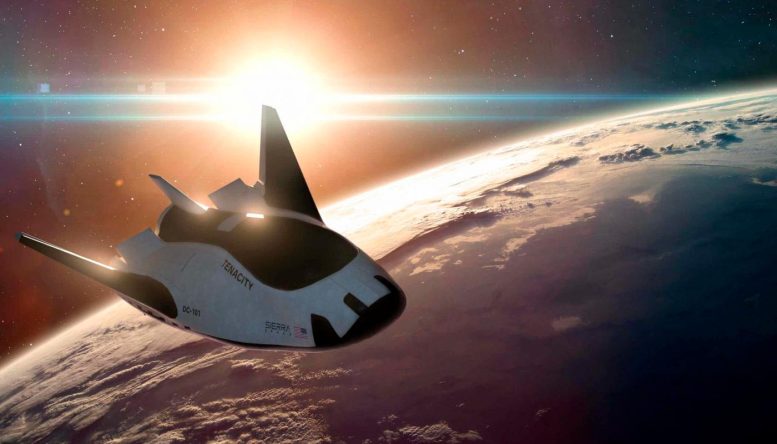
Illustration of Sierra Space’s first Dream Chaser, named DC#1 (Tenacity). The Dream Chaser spacecraft, developed by Sierra Space for NASA, is preparing for a 2024 demonstration mission to the ISS, focusing on cargo delivery and in-orbit certification. Credit: Sierra Space
NASA and Sierra Space’s Dream Chaser spacecraft is set for a 2024 demonstration flight to the ISS, involving cargo delivery and various in-orbit tests to ensure its operational readiness for future missions.
NASA and Sierra Space are making progress on the first flight of the company’s Dream Chaser spacecraft to the International Space Station. The uncrewed cargo spaceplane is planned to launch its demonstration mission in 2024 to the orbital complex as part of NASA’s commercial resupply services.
Dream Chaser and Shooting Star
The Dream Chaser cargo system, manufactured by Sierra Space in Louisville, Colorado, consists of two major elements: the Dream Chaser spacecraft and the Shooting Star cargo module. As a lifting body spacecraft, Dream Chaser is designed to be reused up to 15 times, and is modified from the HL-20 spacecraft developed at NASA’s Langley Research Center in Hampton, Virginia.
The spaceplane’s cargo module companion, Shooting Star, is designed to support delivery and disposal of pressurized and unpressurized cargo to and from the space station. The cargo module can be used only once and is disposed of prior to re-entry.
The Dream Chaser system will launch with its wings folded inside a five-meter fairing aboard a ULA (United Launch Alliance) Vulcan Centaur rocket from Space Launch Complex 41 at Cape Canaveral Space Force Station in Florida. The fairing panels will protect the spacecraft during ascent but are jettisoned once in orbit. Solar arrays mounted on the cargo module and wings of Dream Chaser are deployed during its autonomous rendezvous to the space station. In the event of a scrub, Dream Chaser is designed to be ready for launch in as little as 24 hours.
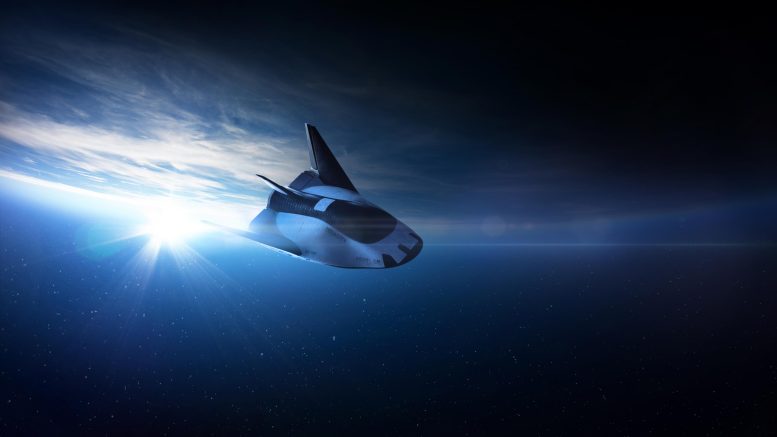
NASA and Sierra Space are making progress on the first flight of the company’s Dream Chaser spacecraft to the International Space Station. The uncrewed cargo spaceplane is planned to launch its demonstration mission in 2024 to the orbital complex as part of NASA’s commercial resupply services. Credit: Sierra Space
Mission Overview
During its first flight, Sierra Space will conduct in-orbit demonstrations to certify Dream Chaser for future missions. Teams at NASA’s Kennedy Space Center in Florida, NASA’s Johnson Space Center in Houston, and the Dream Chaser Mission Control Center in Louisville, Colorado, will monitor the flight. Sierra Space flight controllers will control the Dream Chaser spacecraft on the launch pad until the spacecraft is handed over to the Sierra Space ground operations team at NASA Kennedy following landing.
Far-field demonstrations will be conducted outside the vicinity of the space station before the spacecraft enters the approach ellipsoid, a 2.5-by-1.25-by-1.25-mile (4-by-2-by-2-kilometer) invisible boundary around the orbiting laboratory. These demonstrations will be required before Dream Chaser can enter joint operations with the NASA team at the Mission Control Center in Houston. These include demonstrating attitude control, translational maneuvers, and abort capabilities.
Near-field demonstrations, which must happen closer to the space station, include activating and using light detection and ranging (LIDAR) sensors, responding to commands sent from the space station, retreating from the station when commanded, and holding its approach, first at 1,083 feet (330 meters), then 820 feet (250 meters), and finally, at 98 feet (30 meters) from the station. Following successful completion of the demonstrations, Dream Chaser will move towards the space station.
As Dream Chaser approaches the orbiting laboratory, it will hold a final time approximately 38 feet (11.5 meters) from the space station, when a station crew member will use Canadarm2 robotic arm to grapple a fixture on the spacecraft’s cargo module before teams on the ground install the cargo module to an Earth-facing port on the Unity or Harmony module.
On its first flight to the International Space Station, Dream Chaser is scheduled to deliver over 7,800 pounds of cargo. On future missions, Dream Chaser is being designed to stay attached to the station for up to 75 days and deliver as much as 11,500 pounds of cargo. Cargo can be loaded onto the spacecraft as late as 24 hours prior to launch. Dream Chaser can return over 3,500 pounds of cargo and experiment samples to Earth, while over 8,700 pounds of trash can be disposed of during reentry using its cargo module.
Return to Earth
Dream Chaser will remain at the space station for about 45 days before it is uninstalled using Canadarm2. The spacecraft can land as quickly as 11 to 15 hours after departure, and there are daily opportunities if weather criteria are met. Landing weather criteria for Dream Chaser generally require crosswinds at less than 17.2 miles per hour (15 knots), headwinds under 23 mph (20 knots), and tailwinds below 11.5 mph (10 knots). Thunderstorms, lightning, and rain within a 20-mile radius of the runway or 10 miles along the approach path are not acceptable conditions for landing. Detailed flight rules will guide controllers in determining whether landing opportunities are favorable.
A combination of Dream Chaser’s 26 reaction control system thrusters will fire to commit the spacecraft to deorbit. Dream Chaser will re-enter Earth’s atmosphere and glide to a runway landing at Kennedy’s Launch and Landing Facility in the style of NASA’s space shuttle, becoming the first spacecraft to land at the facility since the final space shuttle flight in 2011.
Once Dream Chaser is powered down after landing, the Sierra Space ground operations team will transfer it to the Space System Processing Facility to perform necessary inspections, off-load remaining NASA cargo, and begin the process of preparing it for the next mission.
Sierra Space, formerly Sierra Nevada Corporation, was selected in 2016 as NASA’s third commercial cargo resupply spacecraft to service the International Space Station.



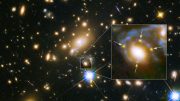

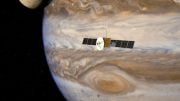


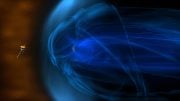
Be the first to comment on "Sierra Space’s Dream Chaser Spaceplane: Revolutionizing ISS Resupply for NASA"